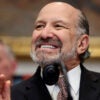Mayor Bill de Blasio wants to tackle income inequality—not just in New York City, but across the country. De Blasio, who was elected on his “Tale of Two Cities,” has launched a national task force of mayors to address what he calls “the growing inequality crisis in America.”
In reality, there is no crisis. While it’s true that income inequality has risen in recent decades, upward income mobility has not declined. Contrary to what pundits and politicians on the Right and the Left have been repeating incessantly, it simply hasn’t become too hard to make it in America. It is no harder to make it today than it was 30 years ago or 50 years ago.
The most comprehensive study of upward mobility ever conducted in the U.S. looked at 750 metropolitan areas in America—including de Blasio’s New York City—and concluded that “a high concentration of income in the top 1 percent was not highly correlated with mobility patterns” and that “economic mobility has not changed significantly over time.” In other words, even if the richest of the rich have grown richer, that’s not preventing other Americans from earning more.
It is true that there are pockets of persistent poverty and blighted neighborhoods, but they are not caused by the gains of the wealthy. The fortune of Michael Jordan, who once lived in the wealthy suburb of Highland Park, was not built at the expense of the residents of the South side of Chicago.
De Blasio and the other mayors should take a cue from the collapse of the Occupy Wall Street movement, and abandon the outdated and discredited inequality talk. They should instead direct their efforts to expanding opportunity for those born into the poorest parts of their cities.
To be sure there is plenty of talk of opportunity in the press release announcing the creation of the task force. In fact, de Blasio named it “Cities of Opportunity.” While the name may inspire, the policies initially put forward do not.
It’s more of the same old, tried, tested and failed ideas that progressives refuse to move beyond, such as a higher minimum wage and universal pre-kindergarten. The former squeezes unskilled workers out of the job market while the latter doesn’t improve educational achievement.
If the mayors really wanted to try something bold, they could set their sights on firing up the engines of economic growth. They could take on the vested interests that stifle competition and restrict opportunity. They could say: “To build Cities of Opportunity, let us first raze the Cities of Cronyism that exist throughout America.”
The mayors could, for example, abolish unfair licensing requirements. Almost all cities needlessly limit the number of taxicabs in operation, thereby denying any poor person with a car a simple way to earn a living. New York City, with a population of 8 million, permits only 853 non-food street vendors in the entire city, thereby restricting employment for countless low-income immigrants who have fewer job opportunities.
The mayors also could cut red tape at city hall to make it easier for people to start businesses. Or they could muster the courage to take on education reform in their cities. They could try something even more courageous and reform public pensions. They could invite Center for Neighborhood Enterprise founder Bob Woodson to talk about the importance of strong civic ties in the fight against urban poverty.
They could do all this—and more. But their misguided focus on inequality, coupled with a failure to even contemplate bold reforms that empower people and promote economic growth, suggests they won’t.































